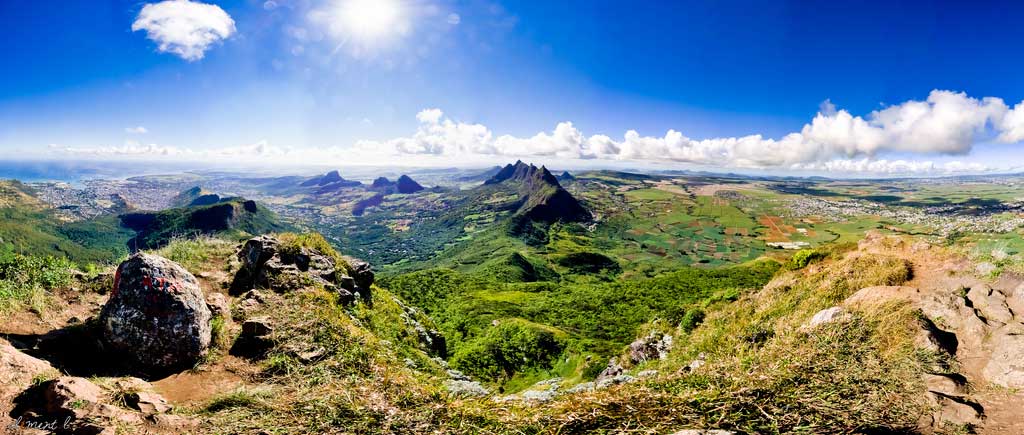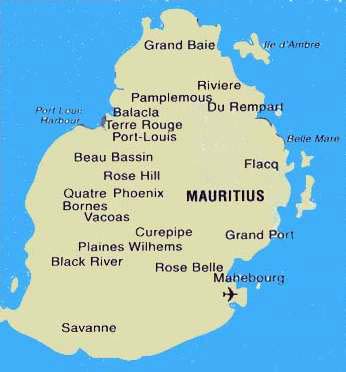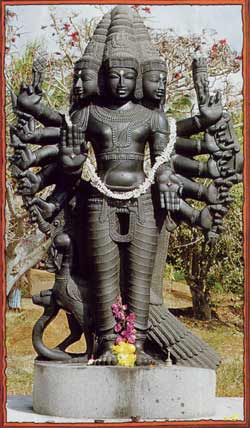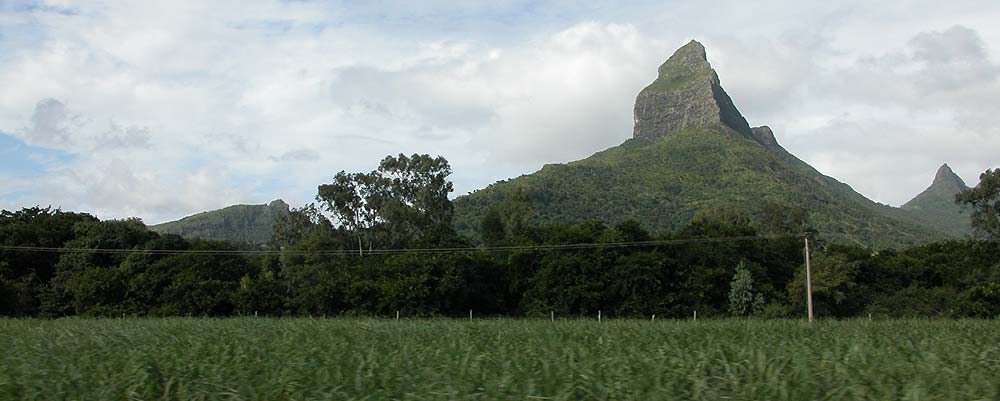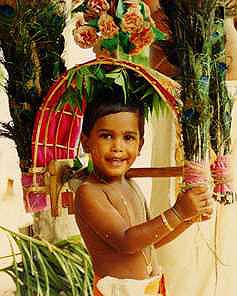
|
||||||||||||
|
| ||||||||||||
The Murukan Cult in MauritiusEssence of Tamil Ethnic Identity
Tamil: மொரீஷியஸில் முருக வழிபாடுby Khesaven SornumNote: The Second International Conference on Skanda-Murukan 24-28 April, 2001 was hosted by Mauritius. IntroductionThe earliest and sublimest Tamilian concept of Godhead has been called by the pure Tamil word Murukan.1 Murukan has been closely associated with the life of the Tamils from time immemorial. They have been worshipping Him as the embodiment of beauty, the source of spiritual wisdom and the personification of limitless power. The most ancient famous Tamil grammar Tolkāppiyam refers to Murukan as Cēyon and the God that is present in the hilly areas. The rich materials enshrined in the Cankam classics endorse the fact that Murukan was fervently invoked by devotees from various stratas of society. Murukan has been cherished and venerated in the Tamil land and other countries of the Tamil diaspora. The early Tamil immigrants from South India, mostly craftsmen and traders, settled in Mauritius in the eighteenth century during the French colonisation. They were the builders of many places of worship. Later on, many Tamil indentured labourers also settled in Mauritius along with other ethnic and linguistic groups from India, China, Africa and Madagascar. Nothing could prevent the Tamils from keeping their identity.
One important element characterising the identity of the Tamils is their strong belief in their ancestral values and their religion which they would rather call Tamilism or Tamil religion. In concordance with the words of the Poet Nāmakkal Kavignar Rāmalinkam Pillai "A Tamilian race does exist and that a special characteristic it does possess".2 The Tamils of Mauritius are identified by other communities as the worshippers of the Tamil God -- Murukan. Religious festivals like Tīmiti, Kanji, Gōvinthan and others are celebrated region wise and on various occasions by the Tamils but kāvati festivals like Taippucam has a national dimension. What philosophers consider as folk religion has now taken shape as popular religion. A fine example is the Taippucam kāvati festival which is celebrated with much fervour and massive participation on a national level. Taippucam Day has been decreed public holiday since more than half a century. It is true that in Mauritius Tamils are identified mostly by their religion and culture. Ethnicity would rather be marked by religion and culture. Nevertheless during religious festivals and cultural events a wider use of Tamil language is noticed. In view to have a clear idea of the specificity of the Murukan cult Mauritius and how far it is the essence of ethnic identity various elements and aspects of this cult should be closely looked at.
Brief history of Murukan cult in MauritiusThe Murukan cult had its root planted in Mauritius ever since the first Tamil immigrants came as craftsmen and traders under French rule. Their close attachment to their religion prompted them to build kōvils. A few kōvils were erected as per the norms laid down in the agamas. A fine example would be the Sockalingum Meenatchee Amman Kōvil of Port-Louis. The Dandāyudhapāni Kōvil of Clemencia is considered as the oldest Murukan Kōvil. With the immigration of indentured labourers from many parts of India, many Tamils settled on sugar estates. At all those places, kōvils were built as places or worship and social gatherings. This endeavour had the support of the estate owners who were mostly French settlers. Besides allotting a plot of land for their cult, the estate owners sponsored the special ceremonies performed before the harvest. By the year 1960, nearly 110 kōvils existed already. The Government started distributing subsidy to the kōvils duly registered and affiliated to the Mauritius Tamil Temples Federation. At present, thirty kōvils have Murukan as main deity and all other Amman and Civan kōvils have Murukan deity because in all kōvils, kāvati celebrations do take place. An Indian nationalist Rājaretnum Mudaliar who served the cause of Tamil education in Mauritius was so infatuated with the Murukan Cult that he asked permission to organise a kāvati procession in Port-Louis in 1874.3 With access to education, nowadays the Murukan cult is being developed and consolidated. While few arcakars on contract from Tamil Nadu are serving in Mauritius, many youngsters have shown interest in getting trained to serve in kōvils. Apart from the great Taippucam festival, many other Murukan festivals have been organised in the past twenty-five years. Pankuni Uttiram, Cittirai Paruvam, Aadee Kārtikkai, Āvani Mūlam, Vaikāci, Vicākam, Kanta Sashti and Kārtikkai Tīpam have been included in the calendar of Tamil festivals in Mauritius. Tiruppukal songs are recited by Tamil school children. Many kōvils are being renovated in the Dravidian Kōvil Architecture style. The media is playing an important role in popularising the cult. Murukan who is also named Kali Yuga Varatan would stretch his rule for many more years to come and Mauritius would be a well known place for Murukan Cult. Elders and Local Archagars have been very keen in maintaining uniformity in the various rituals pertaining to the cult, though few Archagars from Tamil Nadu and Sri Lanka have been serving in Mauritius in the past.
Places of worshipThe Tamils who settled in this land considered it a must to have places for worshipping God. In all Tamil houses, the picture of Murukan, the Vēl, the cempu (brass pot) can been seen. These are meant for worship. Since kōvil worship was considered very important, the Tamils built their kōvils on all sugar estates and other places where they were living. Some were small and others big enough to accommodate the devotees. The early Tamilian mind revelled in the natural beauty of the hills and forests wherein human civilisation originated and started the process of migration of settlement to other places, then to the sea boards from wherein the Tamilian carried on his enterprises on the seas. The natural beauty attracted him and developed in him a deeper appreciation of nature in all its beauty and found in him the divinity of nature. The concept of divinity was from experience and worship of nature and that divinity was personified and called 'Muruka'.4 In Mauritius also the Murukan cult is closely associated with natural surroundings. All kāvati processions would normally start from river banks or seaside to proceed to the kōvils. Many of such kōvils are found on sugar estates and few on hilltops. Moreover, it was conceived that Murukan had his special abode on every hill (Kunrudōrādal). Tolkāppiyam refers to Murukan and His abode as 'Cēyon meya maivarai ulagam'.5 The main abodes of Murukan are called 'Pataivītukal' by the poet Nakkīrar. Mention is made in the Tirumurukārruppatai of six main 'Pataivītukal'. The Tamils in Mauritius think of Palani as most important place of worship. Almost everybody dreams to have a pilgrimage at Palani which they consider to be the Mecca for the Tamils. For Mauritius, the Murukan Kōvil of Corps de Garde Mountain is a Padaivītu. 'Oh Lord, I have not seen Tanikai Malai Such are the heart melting words of the hymn "The Mauritius Murukan Pāmālai", composed by P. Tiroumale Chetty, a Mauritian poet.
John Spiers, the English Editor of Values wisely says of the religion of the Tamils,
"It is linked with the natural pantheism or by lozoism which
recognises deity in stone river, tree, animal as well as in men."
According, Murukan worship takes place almost everywhere in Mauritius.
The VēlThe spear-like weapon in the hand of Murukan is his instrument of chastisement and salvation. Vēl is also understood to typify His energy of wisdom - Jñāna Śakti. It is often the symbol by which Murukan is worshipped. It has a distinct connotation to mean Murukan Himself. The Śakti Vēl heads the kāvati processions. Vēl Abhisēkam is an important ritual before kāvati procession takes place. Murukan devotees have Vēl tattooed on their bodies. As an act of penance, devotees carrying kāvati or Vēl, have their tongues, cheeks and other parts of their body pierced with silver needles having the shape of tiny Vēls. A small silver vēl is fixed in a lemon and tied up to the kāvati and pālkutam during procession. In all the hymns of Murukan, the Vēl is mentioned. 'Verrivēl Murukanukku', 'Vēl vēl' are repeatedly uttered by devotees. It is common in Mauritius that thousands of Tamilians bear names having the word vēl. Tanka vēl, Pyneevēl, Kumāravēl, Vativēl, Katirvēl, Senthilvēl, Vēlan, are among one various names. In choosing a name for new born babes, Murukan's name is preferred and given priority. Fasting and PenanceThe Tamils are God-fearing people by nature. Such attitude is apparent during Murukan festivals. Fasting is considered very important. Tamils in Mauritius usually go to kōvils on Fridays and consume vegetarian food only. But nowadays in many Tamil homes Tuesdays are observed as fasting days in honour of Murukan. Every month on Kārtikkai day and Sashti day fasting is observed in many Tamil families. However, prior to each kāvati festival, ten days of strict fasting is observed by devotees. Vegetarian food, abstinence from sex and liquor, sleeping on mats, consuming food prepared only at home, non-attending of wedding, funeral, etc. are considered as vital during fasting period. That is why in Mauritius Tamils do not marry in the month of Tai. All devotees carrying the kāvatis or pālkutams have to either tie up their mouths with cloth or have their tongues pierced with small silver veils (nakkalus, puttalus) as an act of self-mortification. This mortifications are intense in certain cases where devotees sleep on nail beds, walk on nail slippers, pull chariots with hooks fixed in their flesh, cover their bodies with Vēls. Devotees as well as all those accompanying the kāvati have to walk barefooted in the hot sun. The soul-stirring hymn recitation of PulampālThe recitation of sacred hymns (padikams) with an imploring tone craving for the grace of Murukan is very typical in Mauritius. Such hymns are recited at the time of pūcai and mortification. The most popular hymns for pulambal are Avinasip Pattu Ārumuka Swami Viruttam, and Mauritius Murukan Pāmālai. After each pause in the recitation loud utterance of 'Harō Harā' fills the atmosphere with a strange spirit of awe and bhakti. Many devotees go in trance while hearing the hymns. Such Pulambal is heard all along the way to the kōvil. These songs are also recorded on cassettes and played at home, in kōvils and during religious processions. "I don't know whether I am praying to you with full clear hands Procession (ūrvalam)Procession by devotees carrying kāvatis, Vēls, pālkutams to the kōvils forms part in the Murukan cult. Devotees pulling chariots in front of the procession with concentrated devotion, piously proclaiming the name of Murukan, the thrilling roar of 'Haro Hara' raised by all devotees to the accompaniment of nadaswaram, the sight of the majestic car rumbling slowly along the street furnish an occasion for active community worship.7 Many devotees stand or both sides of the way holding their offerings (coconuts, fruits, camphor, incense, betel leaves etc.) and wait for their turn to give the offerings and worship the Lord. Some devotees smash coconuts on the way. Some others who are afflicted with diseases lie down to be crossed over by devotees carrying the kāvati. Frenzy is possible and indulged in unashamedly as for instance the kāvati carrier. The individual man or woman can enjoy the experience of divine tremors, especially when hearing devotional hymns and concentrating on the Lord. For more inforation, contact the author:
Other articles from the First International Conference on Skanda-Murukan |
